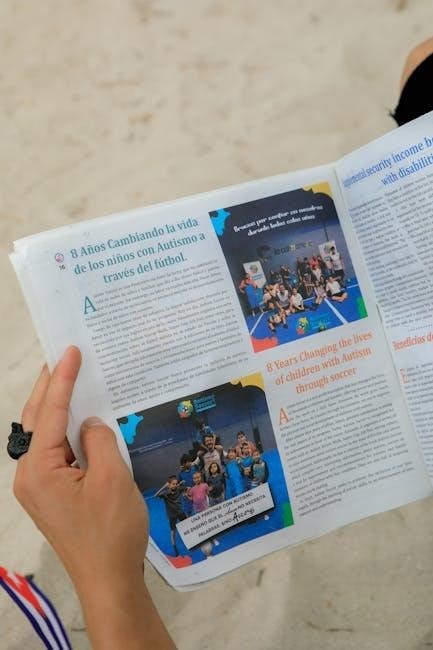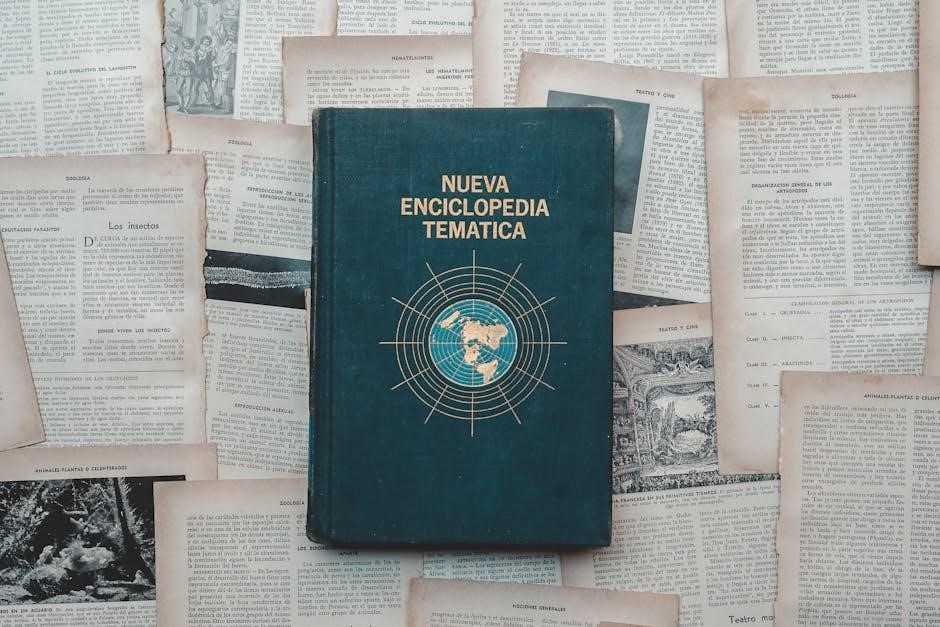The AP Spanish Language and Culture course is an intermediate-level program equivalent to a college Spanish class, focusing on communication modes and cultural themes․
Overview of the Course Structure
The AP Spanish Language and Culture course is structured to develop students’ language proficiency and cultural understanding․ It is taught entirely in Spanish and focuses on three communication modes: interpersonal, interpretive, and presentational․ The curriculum is divided into six thematic units, including families and communities, personal and public identity, and beauty and aesthetics․ Each unit integrates cultural products, practices, and perspectives, allowing students to explore historical and contemporary contexts․ The course emphasizes real-life applications of language and culture, preparing students for college-level coursework․ By engaging with authentic materials and interactive activities, students enhance their critical thinking, language skills, and cultural awareness, fostering a deeper appreciation for Spanish-speaking societies․ This comprehensive approach ensures a well-rounded educational experience․
Importance of the Course in Language and Cultural Proficiency
The AP Spanish Language and Culture course plays a pivotal role in fostering advanced language skills and cultural awareness․ By immersing students in authentic Spanish materials, it bridges academic learning with real-world applications, enhancing their ability to communicate effectively․ The course emphasizes cultural proficiency, enabling students to understand and appreciate the diverse traditions, values, and perspectives of Spanish-speaking communities․ This dual focus on language and culture prepares students for global engagement, making them more open-minded and adaptable in multicultural settings․ Ultimately, the course equips learners with the tools to navigate not only academic challenges but also the complexities of intercultural interactions, fostering lifelong language proficiency and cultural sensitivity․
Key Themes in the AP Spanish Language and Culture Curriculum
The AP Spanish Language and Culture curriculum is organized around key themes such as families, identity, and beauty, exploring cultural and social aspects in Spanish-speaking communities․
Families and Communities
The theme of Families and Communities in the AP Spanish Language and Culture course explores the structure and values of families across Spanish-speaking societies․ Students examine cultural practices, social interactions, and challenges faced by families, fostering an understanding of their roles within communities․ This section emphasizes the importance of family as a foundation for cultural identity, highlighting traditions, gender roles, and generational differences․ By engaging with authentic materials, students develop linguistic skills while gaining insights into how families contribute to societal cohesion and cultural heritage․ This thematic approach encourages students to reflect on their own experiences and compare them with those in Spanish-speaking contexts․
Personal and Public Identity
The theme of Personal and Public Identity in the AP Spanish Language and Culture course delves into how individuals define themselves within their communities and society․ Students explore concepts such as personal values, beliefs, and cultural norms that shape identity․ This section also examines how public figures, media, and societal expectations influence self-perception and group belonging․ Through authentic materials like literature, art, and media, students analyze how identity is expressed and negotiated in Spanish-speaking cultures․ They engage in discussions and reflections that connect their own experiences with those of others, fostering empathy and cross-cultural understanding․ This theme emphasizes the interplay between personal and public identities, highlighting their role in shaping individual and collective narratives․
Beauty and Aesthetics
Beauty and Aesthetics explores how Spanish-speaking cultures perceive and express beauty through various forms of art, literature, and daily life․ Students examine iconic works of art, architecture, and cultural traditions that reflect aesthetic values․ They analyze texts and media that discuss personal and societal interpretations of beauty, including historical and contemporary perspectives․ This theme also touches on the role of nature, urban landscapes, and cultural rituals in shaping perceptions of beauty․ By engaging with authentic materials, students develop a deeper understanding of how beauty is both a personal experience and a cultural construct, influencing identity and creativity in Spanish-speaking societies․

Language Skills Development
The course focuses on enhancing interpersonal, interpretive, and presentational communication skills, enabling students to effectively navigate real-life situations in Spanish, fostering linguistic and cultural proficiency․
Interpersonal Communication
Interpersonal communication in the AP Spanish course involves interactive dialogue, enabling students to express opinions, negotiate meaning, and engage in spontaneous conversations․ This skill is assessed through role-plays and discussions, mirroring real-life interactions․ Students learn to use appropriate language for different social contexts and relationship levels, such as formal and informal speech․ The development of this skill is crucial for building proficiency in Spanish, as it allows learners to connect with native speakers and navigate everyday situations effectively․ By mastering interpersonal communication, students can convey thoughts clearly and understand others, fostering meaningful interactions in both academic and cultural settings․ This section emphasizes practical application and fluency in conversational Spanish․
Interpretive Communication
Interpretive communication focuses on understanding spoken, written, and visual texts in Spanish, such as articles, videos, and conversations․ Students learn to comprehend and analyze diverse materials, including news, literature, and cultural media․ This skill enhances their ability to interpret messages accurately and engage with authentic sources․ Through practice with various texts, students develop critical thinking and cultural awareness, essential for understanding different perspectives within Spanish-speaking communities․ Interpretive communication is assessed through reading and listening exercises, aiming to build proficiency in extracting information, identifying themes, and recognizing cultural nuances․ This skill is vital for connecting language learning to real-world contexts and fostering deeper cultural understanding․
Presentational Communication
Presentational communication involves creating clear and effective messages to convey ideas, opinions, and information in Spanish․ Students engage in producing spoken and written texts, such as essays, presentations, and discussions, to express themselves in both formal and informal contexts․ This mode enhances their ability to organize thoughts logically, use appropriate vocabulary, and employ grammatical structures accurately․ Through presentational tasks, learners develop the skills to articulate their perspectives and share information coherently, preparing them for real-life scenarios like academic or professional settings․ This communication mode emphasizes cultural relevance and the ability to adapt language to different audiences and purposes, fostering confidence in expressing oneself in Spanish․

Cultural Components of the Course
The course explores cultural products, practices, and perspectives, connecting language learning with historical and contemporary contexts to enrich students’ appreciation of Spanish-speaking societies and traditions․
Cultural Products, Practices, and Perspectives
The course emphasizes the exploration of cultural products, such as music, art, and literature, alongside practices like traditions and social interactions․ Perspectives involve understanding the values and viewpoints of Spanish-speaking communities․ Students analyze how these elements shape identity and daily life, fostering a deeper connection to the culture․ By engaging with authentic materials, learners gain insights into historical and contemporary contexts, enriching their language proficiency and cultural awareness․ This approach encourages open-mindedness and appreciation for diverse traditions, preparing students to communicate effectively in real-world situations․
Historical and Contemporary Cultural Contexts
The AP Spanish Language and Culture course delves into the historical and contemporary cultural contexts of Spanish-speaking societies․ Students explore how historical events, traditions, and cultural movements have shaped modern identities and practices․ By examining diverse perspectives, learners gain insights into the evolution of cultural values and their impact on contemporary issues․ The course highlights the interconnectedness of past and present, enabling students to understand the complexities of cultural development․ This dual focus on history and modernity fosters a comprehensive appreciation of Spanish-speaking cultures, preparing students to engage thoughtfully with global perspectives and diverse traditions․

Exam Preparation and Resources
Key resources include free-response questions, scoring guidelines, and study workbooks like Barron’s AP Spanish Language and Culture to enhance exam readiness and understanding of scoring criteria․
Free-Response Questions and Scoring Guidelines
Free-response questions from past AP Spanish Language and Culture exams are available for download, along with scoring guidelines and sample responses․ These resources provide students with insights into the exam format and expectations, helping them prepare effectively․ The questions assess linguistic proficiency and cultural understanding, covering interpersonal, interpretive, and presentational communication modes․ Scoring guidelines emphasize clarity, accuracy, and the ability to address prompts thoroughly․ By reviewing these materials, students can familiarize themselves with the evaluation criteria and improve their performance․ Additionally, the downloadable PDFs offer a practical way to practice and refine skills in alignment with the course objectives․
Study Materials and Workbooks
Various study materials and workbooks are available to help students excel in the AP Spanish Language and Culture course․ Resources like Barron’s AP Spanish Language and Culture and the official College Board study guide provide comprehensive practice exams, cultural insights, and language development strategies․ Additionally, downloadable PDFs and online courses, such as those offered on edX, offer structured lessons and interactive activities․ These materials focus on improving aural/oral skills, reading comprehension, and writing proficiency while exploring cultural themes․ They also include model exams and appendices with valuable tips for mastering the exam․ By utilizing these resources, students can effectively prepare for the challenges of the course and the final exam․

Strategies for Success in the Course
Engage with authentic materials, practice speaking, listening, reading, and writing regularly, and immerse yourself in Spanish-speaking cultures to enhance language and cultural proficiency effectively․
Engaging with Authentic Materials
Engaging with authentic materials is crucial for achieving proficiency in the AP Spanish Language and Culture course․ These materials, such as news articles, videos, and literature, provide real-life contexts for language use․ Students can explore cultural products like music, films, and art, which deepen their understanding of Spanish-speaking societies․ Authentic resources also help learners develop interpretive communication skills by exposing them to diverse perspectives and practices․ Regular interaction with these materials fosters cultural awareness and enhances the ability to connect with native speakers․ This approach not only enriches language learning but also prepares students for the thematic focus of the AP exam, emphasizing communication and cultural competence․
Practicing Speaking, Listening, Reading, and Writing Skills
Practicing the four language skills—speaking, listening, reading, and writing—is essential for success in the AP Spanish Language and Culture course․ Speaking skills are refined through conversations and interactive activities, fostering interpersonal communication․ Listening comprehension is enhanced by exposure to authentic audio materials, such as podcasts and news broadcasts․ Reading proficiency is developed through diverse texts, including articles, essays, and literary excerpts․ Writing skills are strengthened by composing essays, emails, and persuasive texts, emphasizing clarity and cultural appropriateness․ Regular practice in these areas ensures students can effectively communicate in real-life scenarios and excel in all sections of the AP exam, including free-response questions and presentational tasks․
